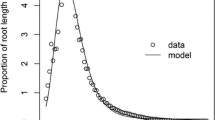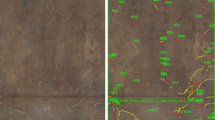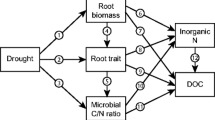Abstract
Background and aims
Plant traits may characterize functional ecosystem properties and help to predict community responses to environmental change. Since most traits used relate to aboveground plant organs we aim to explore the indicative value of root traits.
Methods
We examined the response of root traits (specific root length [SRL], specific root surface area [SRA], root diameter [RD], root tissue mass density [TMD], root N concentration) in six grassland species (3 grasses, 3 herbs) to four management regimes (low vs. high mowing frequency; no fertilization vs. high NPK fertilization). The replicated experiment in temperate grassland with long continuity simulated the increase in grassland management intensity in the past 50 years in Central Europe.
Results
Increasing mowing frequency (one vs. three cuts per year) led to no significant root trait changes. NPK fertilization resulted in considerable trait shifts with all species responding in the same direction (higher SRL, SRA and N concentration, lower TMD) but at different magnitude. Fertilization-driven increases in SRA were mainly caused by lowered tissue density while root diameter reduction was the main driver of SRL increases.
Conclusion
We conclude that root morphological traits may be used as valuable indicators of environmental change and increasing fertilization in grasslands.





Similar content being viewed by others
References
Anderson EL (1988) Tillage and N-fertilization effects on maize root-growth and root - shoot ratio. Plant Soil 108:245–251
Casper BB, Jackson RB (1997) Plant competition underground. Annu Rev Ecol Syst 28:545–570
Craine JM (2005) Reconciling plant strategy theories of Grime and Tilman. J Ecol 93:1041–1052
Craine JM (2009) Resource strategies of wild plants. Princeton University Press, Princeton and Oxford
Craine JM, Dybzinski R (2013) Mechanisms of plant competition for nutrients, water and light. Funct Ecol. doi:10.111/1365-2435.12081
Craine JM, Wedin DA, Chapin FS, Reich PB (2003) The dependence of root system properties on root system biomass of 10 North American grassland species. Plant Soil 250:39–47
Dawson LA, Grayston SJ, Paterson E (2000) Effects of grazing on the roots and rhizosphere of grasses. In: Lemaire G, Hodgson J, de Moraes A, Nabinger C, De F. Carvalho PC (eds) Grassland ecophysiology and grazing ecology. CABI Publishing, Wallingford, pp 61–84
Díaz S, Cabido M (2001) Vive la difference: plant functional diversity matters to ecosystem processes. TREE 16:646–655
Díaz S, Hodgson JG, Thompson K, Cabido M, Cornelissen JHC, Jalili A, Montserrat-Marti G, Grime JP, Zarrinkamar F, Asri Y, Band SR, Basconcelo S, Castro-Diez P, Funes G, Hamzehee B, Khoshnevi M, Perez-Harguindeguy N, Perez-Rontome MC, Shirvany FA, Vendramini F, Yazdani S, Abbas-Azimi R, Bogaard A, Boustani S, Charles M, Dehghan M, de Torres-Espuny L, Falczuk V, Guerrero-Campo J, Hynd A, Jones G, Kowsary E, Kazemi-Saeed F, Maestro-Martinez M, Romo-DÍez A, Shaw S, Siavash B, Villar-Salvador P, Zak MR (2004) The plant traits that drive ecosystems: evidence from three continents. J Veg Sci 15:295–304
Dierschke H, Briemle G (2002) Kulturgrasland. Eugen Ulmer KG, Stuttgart
Eissenstat DM (1992) Costs and benefits of constructing roots of small diameter. Journal of Plant Nutr 15:763–782
Eissenstat DM, Yanai RD (1997) The ecology of root lifespan. Adv Ecol Res 27:1–62
Eissenstat DM, Wells CE, Yanai RD, Whitbeck JL (2000) Building roots in a changing environment: implications for root longevity. New Phytol 147:33–42
Elberse WT, Berendse F (1993) A comparative-study of the growth and morphology of 8 grass species from habitats with different nutrient availabilities. Funct Ecol 7:223–229
Ellenberg H, Weber HE, Düll R, Wirth V, Werner W, Paulißen D (1992) Zeigerwerte von Pflanzen in Mitteleuropa. Scripta Geobotanica 18, 2nd edn. Goltze, Göttingen
Fender A-C, Leuschner C, Schützenmeister K, Gansert D, Jungkunst HF (2012) Rhizosphere effects of tree species – large reduction of N2O emissions by saplings of ash, but not of beech, in temperate forest soil. Eur J Soil Biol 54:7–15
Fiala K (1993) Underground biomass in meadow stands. In: Rychnovská M (ed) Structure and functioning of seminatural meadows. Elsevier, Amsterdam, pp 133–154
Fitter AH (1985) Functional significance of root morphology and root system architecture. In: Fitter AH, Atkinson D, Read DJ, Usher MB (eds) Ecological interactions in soil. Blackwell, Oxford, pp 87–106
Fitter A (1996) Characteristics and functions of root systems. In: Waisel Y, Eshel A, Kafkafi U (eds) Plant roots. The hidden half, 2nd edn. Marcel Dekker, New York, pp 1–20
From T, Petersen U, Isselstein J (2011) Productivity and forage quality of a phytodiverse semi-natural grassland under various management regimes. Nature Precedings http://precedings.nature.com/documents/6622/version/1 Accessed 3 March 2013
Gass P, Oertli JJ (1980) Durchwurzelungsvergleich zwischen Fettwiese und angrenzender Brachwiese. Zeitschrift für Pflanzenernährung und Bodenkunde 143:208–214
Hector A, von Felten S, Schmid B (2010) Analysis of variance with unbalanced data: an update for ecology & evolution. J Anim Ecol 79:308–316
Hunt R, Cornelissen JHC (1997) Components of relative growth rate and their interrelations in 59 temperate plant species. New Phytol 135:395–417
Jackson RB, Canadell J, Ehleringer J, Mooney HA, Sala OE, Schulze E-D (1996) A global analysis of root distributions for terrestrial biomes. Oecologia 108:389–411
Jaramillo VJ, Detling JK (1988) Grazing history, defoliation, and competition - effects on shortgrass production and nitrogen accumulation. Ecology 69:1599–1608
Lauenroth WK, Gill R (2003) Turnover of root systems. In: de Kroon H, Visser EJW (eds) Root Ecology. Ecol Stud 168. Springer, Berlin, pp 61–89
Lukac M, Godbold DL (2011) Soil ecology in northern forests. Cambridge University Press, New York
Maire V, Gross N, Pontes LDS, Picon-Cochard C, Soussana JF (2009) Trade-off between root nitrogen acquisition and shoot nitrogen utilization across 13 co-occurring pasture grass species. Funct Ecol 23:668–679
Matthew C, Assuero SG, Black CK, Sackville Hamilton NR (2000) Tiller dynamics of grazed swards. In: Lemaire et al. (eds) Grassland ecophysiology and grazing ecology. CAB International, pp 127–150
Milchunas DG, Lauenroth WK (1992) Carbon dynamics and estimates of primary production by harvest, 14C dilution and 14C turnover. Ecology 73:1593–1607
Mokany K, Ash JL (2008) Are traits measured on pot grown plants representative of those in natural communities? J Veg Sci 19:119–126
Ostonen I, Lohmus K, Lasn R (1999) The role of soil conditions in fine root ecomorphology in Norway spruce (Picea abies (L.) karst.). Plant Soil 208:283–292
Ostonen I, Puttsepp U, Biel C, Alberton O, Bakker MR, Lohmus K, Majdi H, Metcalfe D, Olsthoorn AFM, Pronk A, Vanguelova E, Weih M, Brunner I (2007) Specific root length as an indicator of environmental change. Plant Biosystems 141:426–442
Petersen U, Wrage N, Köhler L, Leuschner C, Isselstein J (2012) Manipulating the species composition of permanent grasslands - a new approach to biodiversity experiments. Basic Appl Ecol 13:1–9
Polomski J, Kuhn N (1998) Wurzelsysteme. Verlag Paul Haupt, Bern
Poorter H, De Jong R (1999) A comparison of specific leaf area, chemical composition and leaf construction costs of field plants from 15 habitats differing in productivity. New Phytol 143:163–176
Poorter H, Remkes C (1990) Leaf area ratio and net assimilation rate of 24 wild species differing in relative growth rate. Oecologia 83:553–559
Reich PB, Walters MB, Ellsworth DS (1997) From tropics to tundra: global convergence in plant functioning. PNAS 94:13730–13734
Reich PB, Ellsworth DS, Walters MB (1998a) Leaf structure (specific leaf area) modulates photosynthesis-nitrogen relations: evidence from within and across species and functional groups. Funct Ecol 12:948–958
Reich PB, Walters MB, Tjoelker MG, Vanderklein D, Buschena C (1998b) Photosynthesis and respiration rates depend on leaf and root morphology and nitrogen concentration in nine boreal tree species differing in relative growth rate. Funct Ecol 12:395–405
Reich PB, Buschena C, Tjoelker MG, Wrage K, Knops J, Tilman D, Machado JL (2003) Variation in growth rate and ecophysiology among 34 grassland and savanna species under contrasting N supply: a test of functional group differences. New Phytol 157:617–631
Richards JH (1984) Root-growth response to defoliation in 2 Agropyron bunchgrasses - field observations with an improved root periscope. Oecologia 64:21–25
Robinson D, Hodge A, Fitter A (2003) Constraints on the form and function of root systems. In: de Kroon H, Visser EJW (eds) Root Ecology. Ecol Stud 168. Springer, Berlin, pp 1–31
Rose L, Leuschner C (2012) The diversity-productivity relationship in a permanent temperate grassland: negative diversity effect, dominant influence of management regime. Plant Ecol & Diversity 5:265–274
Rose L, Rubarth MC, Hertel D, Leuschner C (2013) Management alters interspecific leaf trait relationships and trait-based species rankings in permanent meadows. J Veg Sci 24:239–250
Roumet C, Urcelay C, Díaz S (2006) Suites of root traits differ between annual and perennial species growing in the field. New Phytol 170:357–368
Ryser P (1996) The importance of tissue density for growth and life span of leaves and roots: a comparison of five ecologically contrasting grasses. Funct Ecol 10:717–723
Ryser P (2006) The mysterious root length. Plant Soil 286:1–6
Ryser P, Lambers H (1995) Root and leaf attributes accounting for the performance of fast-growing and slow-growing grasses at different nutrient supply. Plant Soil 170:251–265
Thorne MA, Frank DA (2009) The effects of clipping and soil moisture on leaf and root morphology and root respiration in two temperate and two tropical grasses. Plant Ecol 200:205–215
Tjoelker MG, Craine JM, Wedin D, Reich PB, Tilman D (2005) Linking leaf and root trait syndromes among 39 grassland and savannah species. New Phytol 167:493–508
Trubat R, Cortina J, Vilagrosa A (2006) Plant morphology and root hydraulics are altered by nutrient deficiency in Pistacia lentiscus (L.). Trees-Structure and Funct 20:334–339
Van der Krift TAJ, Berendse F (2002) Root life spans of four grass species from habitats differing in nutrient availability. Funct Ecol 16:198–203
Wahl S, Ryser P (2000) Root tissue structure is linked to ecological strategies of grasses. New Phytol 148:459–471
Withington JM, Reich PB, Oleksyn J, Eissenstat DM (2006) Comparisons of structure and life span in roots and leaves among temperate trees. Ecol Monogr 76:381–397
Wright IJ, Reich PB, Westoby M, Ackerly DD, Baruch Z, Bongers F, Cavender-Bares J, Chapin T, Cornelissen JHC, Diemer M, Flexas J, Garnier E, Groom PK, Gulias J, Hikosaka K, Lamont BB, Lee T, Lee W, Lusk C, Midgley JJ, Navas ML, Niinemets Ü, Oleksyn J, Osada N, Poorter H, Poot P, Prior L, Pyankov VI, Roumet C, Thomas SC, Tjoelker MG, Veneklaas EJ, Villar R (2004) The worldwide leaf economics spectrum. Nature 428:821–827
Acknowledgments
This study is part of the Cluster of Excellence ‘Functional Biodiversity Research’, funded by the Ministry of Science and Culture of Lower Saxony and the “Niedersächsisches Vorab”. The financial support is gratefully acknowledged. We thank Dietrich Hertel for valuable advice during the field campaign and Lars Köhler for manifold support with the site management.
Author information
Authors and Affiliations
Corresponding author
Additional information
Responsible Editor: Duncan D. Cameron.
Rights and permissions
About this article
Cite this article
Leuschner, C., Gebel, S. & Rose, L. Root trait responses of six temperate grassland species to intensive mowing and NPK fertilisation: a field study in a temperate grassland. Plant Soil 373, 687–698 (2013). https://doi.org/10.1007/s11104-013-1836-4
Received:
Accepted:
Published:
Issue Date:
DOI: https://doi.org/10.1007/s11104-013-1836-4




